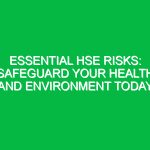Introduction
Understanding the term PPE—an acronym for Personal Protective Equipment—is crucial in the context of health, safety, and Environment (HSE). In an era where Workplace Safety is paramount, the meaning and application of PPE take on significant importance. This article delves into what PPE means, its relevance in HSE, and how it serves as a critical line of defense against a multitude of Hazards present in various environments.
What Does PPE Mean?
PPE encompasses equipment designed to protect the user from exposure to Hazards that can cause serious injuries or illnesses. This equipment can include items like helmets, gloves, goggles, earplugs, respirators, and full-body suits. The primary function of PPE is to reduce the risk of injury or illness in workplaces where hazards exist. Understanding what PPE means entails recognizing the various types, their applications, and the importance of proper usage and Maintenance.
The Role of PPE in Health, Safety, and Environment (HSE)
PPE plays a vital role in the HSE framework by providing a barrier between the worker and potential hazards. In various industries—from construction to healthcare—workers face different types of risks, such as chemical exposure, physical injuries, and environmental pollutants. PPE becomes essential in mitigating these risks and ensuring a safer work environment.
Key Components of PPE
To fully grasp what PPE means, it is essential to explore its various components. Each type of PPE serves a specific purpose:
- Head Protection: Hard hats protect against falling objects and head injuries.
- Eye and Face Protection: Safety Goggles and face shields safeguard against flying debris, chemicals, and other hazards.
- Respiratory Protection: Respirators filter harmful substances from the air, protecting the lungs from inhalation hazards.
- Hand Protection: Gloves protect against cuts, burns, and chemical exposure.
- Foot Protection: Steel-toed boots prevent injuries from heavy objects falling on feet.
- Body Protection: Coveralls and vests shield against chemicals, heat, and biohazards.
Understanding Hazards and Risk Assessment
To comprehend the significance of PPE, one must first identify the hazards present in various work environments. Common hazards may include:
- Chemical Hazards: Exposure to toxic substances can lead to serious health issues.
- Physical Hazards: These include falls, machinery accidents, and electrical risks.
- Biological Hazards: In healthcare settings, exposure to pathogens is a significant risk.
- Environmental Hazards: Extreme temperatures, noise, and radiation are concerns in many industries.
Conducting a thorough risk assessment helps determine the appropriate type of PPE needed. For instance, a construction site may require hard hats and Safety goggles, whereas a laboratory may need chemical-resistant gloves and goggles.
Best Practices for PPE Usage
To maximize the effectiveness of PPE, it’s essential to follow Best Practices:
- Proper Training: Workers must receive training on how to use and maintain their PPE correctly.
- Regular Inspections: PPE should be inspected regularly for wear and tear and replaced as needed.
- Correct Fit: PPE must fit properly to provide adequate protection. Ill-fitting equipment can lead to injuries.
- Maintenance: Regular cleaning and maintenance of PPE ensure longevity and effectiveness.
Real-Life Scenarios: The Importance of PPE
Consider a construction worker on a high-rise building site. Without a hard hat, a falling object could lead to severe injury or even death. In another scenario, a healthcare worker handling infectious materials without proper gloves and masks is at risk of contamination. These examples underscore the critical role PPE plays in safeguarding workers’ health and Safety.
Regulatory Framework and Standards
Numerous Regulations govern the use of PPE in the workplace. In the United States, the Occupational Safety and Health Administration (OSHA) sets forth standards that require employers to provide appropriate PPE to employees exposed to hazards. Similarly, the European Union has established regulations that mandate the use of PPE in various industries.
Compliance with these regulations not only protects employees but also enhances overall Workplace Safety and productivity. Employers must conduct regular assessments to determine the necessary PPE and ensure that it meets the required safety standards.
Impact of Non-Compliance
Failure to adhere to PPE regulations can have dire consequences. Companies may face hefty fines, legal repercussions, and damage to their reputation. Moreover, employees may suffer preventable injuries, leading to loss of productivity and increased insurance costs. Thus, understanding the importance of PPE is not merely a matter of compliance but a critical aspect of organizational culture.
The Future of PPE and Innovations
The landscape of PPE is constantly evolving. Innovations such as smart helmets equipped with augmented reality, advanced respiratory protection with real-time monitoring, and sustainable materials are making PPE more effective and user-friendly. These advancements not only enhance safety but also improve the overall user experience.
Moreover, the COVID-19 pandemic highlighted the importance of PPE, particularly in healthcare settings. The surge in demand for high-quality masks and protective gear has led to increased research and development in the field, potentially leading to more effective solutions in the future.
Conclusion
Unlocking the meaning of PPE reveals its essential role in health, safety, and environmental protection. As workplaces evolve and new hazards emerge, the need for effective PPE becomes increasingly critical. Understanding what PPE means, adhering to Best Practices, and complying with regulatory standards are pivotal in promoting a culture of safety. By prioritizing PPE, organizations can not only protect their employees but also foster a safer, more sustainable work environment for all. As we move forward, continual education and innovation in the realm of PPE will be key to addressing the challenges of tomorrow.


